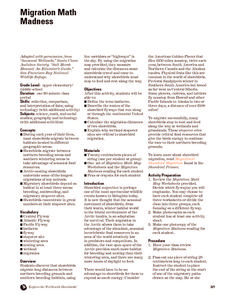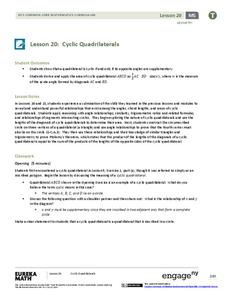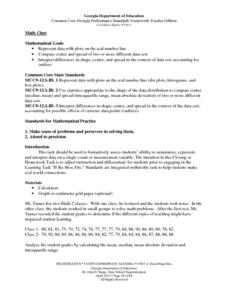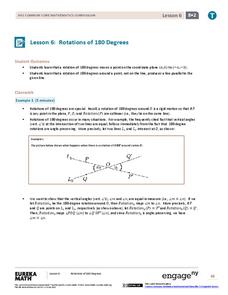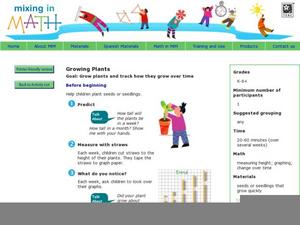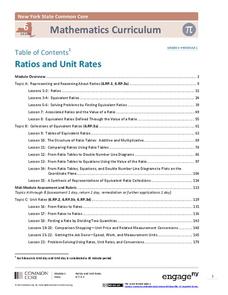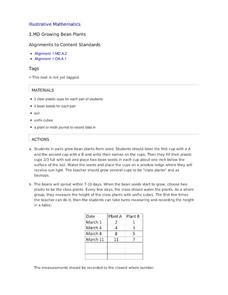Prince William Network
Migration Math Madness
A great way to incorporate math into life science, this lesson has learners measure migratory routes on a map and calculate the actual distance that shorebirds on the routes would cover. Learners compute the distance covered in both...
Charleston School District
Parallel Lines Cut by a Transversal
Pupils study angle measurements between different types of angles associated with parallel lines and transversals. The independent practice asks pupils to identify the types of angles in a diagram and to determine the measure of...
EngageNY
Cyclic Quadrilaterals
What does it mean for a quadrilateral to be cyclic? Mathematicians first learn what it means for a quadrilateral to be cyclic. They then investigate angle measures and area in such a quadrilateral.
Georgia Department of Education
Math Class
Young analysts use real (provided) data from a class's test scores to practice using statistical tools. Not only do learners calculate measures of center and spread (including mean, median, deviation, and IQ range), but...
EngageNY
Rotations of 180 Degrees
What happens when rotating an image 180 degrees? The sixth lesson plan in the series of 18 takes a look at this question. Learners discover the pattern associated with 180-degree rotations. They then use transparency paper to perform the...
EngageNY
Conversion Between Celsius and Fahrenheit
Develop a formula based upon numerical computations. The 31st part of a 33-part unit has the class determine the formula to convert a temperature in Celsius to a temperature in Fahrenheit. They do this by making comparisons between the...
Curated OER
New Ways to Measure
Students recognize that measuring tools can come in many different shapes and sizes. For this early childhood math lesson, students develop creative-thinking, math, and social skills as they use nontraditional measuring tools.
Curated OER
Is That Measurement Stuff For Real, Life?
Fifth and sixth graders engage in a series of activities which show them the importance of using different types of measurement strategies. One of the primary goals of the lesson is to show learners that measurement is helpful in many...
Curated OER
The Circle's Measure
Listen to the story "Sir Cumference and the Dragon of Pi" and solve the riddle and to save Sir Cumference from the knights. Your students will love mixing an activity with story and will practice their measuring skills while...
Curated OER
Solar Kit Lesson # 12 - Calibration Curve for a Radiation Meter
Scientists need to have mastered algebraic slope-intercept concepts in order for this instructional activity to be effective. They will measure and graph solar panel output as a function of the amount of radiation striking it,...
Mixing In Math
Mixing in Math: Growing Plants
Whether you have your class plant seeds or begin when sprouts are visible, math skills are used here to predict and track growth over time. Straw bar graphs show plant height on a given day while the graph as a whole shows changes over...
EngageNY
Ratios and Unit Rates
This turn-key unit on ratios and unit rates walks through a 30-lesson unit on teaching proportional reasoning, with each lesson broken into detailed teaching notes and time allotments for all parts. An unbelievable resource when taken...
Curated OER
Fish Communities in the Hudson
Learning to read data tables is an important skill. Use this resource for your third, fourth, or fifth graders. Learners will will study tables of fish collection data to draw conclusions. The data is based on fish environments in the...
Curated OER
Measure: Bearings and Scale Drawings
Young mathematicians practice measuring acurately with a protractor. They convert measurements using a scale factor, then translate the new information into diagrams. This lesson should be a hit in that it's mostly hands-on work with the...
Curated OER
Measuring the Lengths Using Rulers
Why are there so many lines on a ruler? Scholars measure length on two rulers, one standard and one metric. They measure in inches, millimeters, and centimeters with the centimeter measurement including a fraction. Because these are the...
Curated OER
Measurement Tools
Which of these is the best tool for the job? Learners examine a measurement scenario and determine which of five tools would be the right choice. There is only one problem, and the worksheet includes pictures. Because the answer is...
Curated OER
Lesson 3: Measuring Angles
Students use a protractor to measure angles. They classify angles by type: right angle, acute angles, and obtuse angles. Students build and draw right, acute, and obtuse angles. They discuss how do people in various professions use...
Curated OER
Industrialization, Chemicals and Human Health - Math
Young scholars review the units of the metric system, and practice estimating measures before actually converting between the two systems of measurement. They participate in activities to visualize a concentration of one part per...
Curated OER
Measuring Pumpkins and Our World
Students estimate the circumference of a pumpkin. They measure the pumpkin and other school objects, and record the measurements on worksheets.
Illustrative Mathematics
Growing Bean Plants
Plant growth experiments offer rich, cross-curricular learning opportunities that can really excite and engage young learners. In this series, children work in pairs planting, measuring, and comparing the height of bean plants in order...
EngageNY
Describing Distributions Using the Mean and MAD
What city has the most consistent temperatures? Pupils use the mean and mean absolute deviation to describe various data sets including the average temperature in several cities. The 10th lesson plan in the 22-part series asks learners...
Curated OER
Oversized Inc
Fourth graders become familiar with fractional parts of a ruler. In this measurement lesson, 4th graders measure various objects to an 1/8 of an inch. Students measure a piece of paper based on teacher direction....
EngageNY
End-of-Module Assessment Task: Grade 7 Mathematics Module 6
Determine the level of understanding within your classes using a summative assessment. As the final lesson in a 29-part module, the goal is to assess the topics addressed during the unit. Concepts range from linear angle relationships,...
Curated OER
Measuring Pots of Gold
Have your class practice measuring and weighing "leprechaun's gold" for St. Patrick's Day. In this measurement lesson, students work cooperatively to use scales to measure and weigh pretend gold. They use cups, tablespoons, and ounces to...


